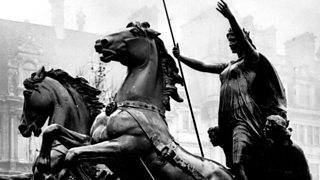Six kick-ass life lessons from a warrior queen
Around 2000 years ago, Boudica (or Boadicea), an Iron Age aristocrat, led a revolt against the mighty Roman invading armies and almost sent them packing. Boudica was an iconic and controversial figure, seen as an early feminist and freedom fighter by many; a brutal warrior and terrorist by others.
Whatever her legacy, she was undoubtedly a formidable leader, with an ability to rally enormous troops from disparate tribes. What modern life leadership lessons can be learnt from the legend of this warrior queen?
1. Power dressing works
We all know the importance of dressing for the job – none so more than Boudica. Commonly depicted as a fierce and powerful woman mounted on a chariot, brandishing a spear, and with her hair streaming out behind, we can’t know what the queen really looked like, but Roman historian Cassius Dio (writing decades after her death) offers this physical description: “In stature she was very tall, in appearance most terrifying, in the glance of her eye most fierce… A great mass of the tawniest hair fell to her hips, around her neck was a large golden necklace; and she wore a tunic of diverse colours over which a thick mantle was fastened with a brooch.” No doubt about it, Boudica was an early adopter of power dressing – with terrifying effect.

2. A kick-ass name goes a long way
The name Boudica is derived from the ancient Brythonic word boud meaning victory. Boudeg means bringer of victory and Boudega – the female alternative – means she who brings victory. Talk about pressure! We can safely presume this wasn’t the name the warrior queen was given at birth, but rather one that she adopted further down the line. And the strong title would certainly have helped in rallying an army. Ultimately, however, the defeated warrior queen didn’t quite live up to her moniker.
3. Never underestimate someone's abilities
Boudica’s husband Prasutagus was the ruler of the Iceni tribe of East Anglia. He was tolerant towards the occupying Romans, and was allowed to continue to rule his people as a result. When Prasutagus died, however, the Romans decided to intervene. They seized lands and – when Boudica refused to pay large taxes – publically flogged her and raped her daughters. But they underestimated the scorned queen! Deciding to fight back, Boudica rallied troops from her own tribe and others. They successfully defeated the Roman Ninth Legion, destroyed the capital of Roman Britain, Colchester, and went on to raze London and St Albans to the ground.
4. Effective training is more valuable than a large workforce
As they say, be prepared! After the fall of London and St Albans the Roman governor decided to rally his troops and confront Boudica’s army. Although hers was many more in number, as presenter Bridget Kendall puts it, the warrior queen’s undisciplined and ill-equipped men “were no match for the better trained and skilled and well-armed Roman troops.” Though she may have had as many as ten times more soldiers, Boudica was defeated by the Roman army.


5. Stand out from the crowd
The attack led by Boudica was not the only one against the Roman occupation but her rebellion stands out in history largely because she was a woman. Dr. Jane Webster explains how, “women leaders offended Roman sensibilities. It wasn’t the order of things… That means we know a great deal more about this rebellion than we do about many others under Rome.” As Miranda Aldhouse-Green puts it, Boudica “is an iconic figure because she was one of the very few women to take on the might of Rome.” (In fact, she remains the only women to have led the combined forces of Britain against an occupying army.) Records we have for Boudica are scarce, lack detail and are often contradictory but “she has remained in the literature and persisted as a fine example of a rebel”, says Jane, because she is female.

6. It’s important to have a role model
During the 16th Century, people began to be interested in classical writers again and Tacitus’s account of Boudica’s rebellion was resurrected. Another important and powerful woman in a man’s world (and a fellow redhead!), Queen Elizabeth I, took great inspiration from Boudica’s story. The Victorians re-imagined Boudica as a figurehead of imperialism and the warrior queen was also an important role model for those involved in the suffragette movement. Professor Richard Hingley explains how, because we know so little about her, “she’s a very flexible and ambiguous figure who can represent very many different things to different people.”
-
![]()
The Forum: Boudica - Warrior Queen
Bridget Kendall and guests discuss Boudica's rebellion against the Romans in Britain.
-
![]()
The modern-day, town planning legacies of the ancient world, from pagan Britain to Babylon.
-
![]()
In Our Time: Boudica
Melvyn Bragg and guests discuss the life and mythologisation of Boudica.
-
![]()
The UK has always had its fair share of unusual customs and odd age-old events.




